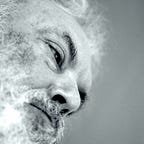The Art of Loving
Hommage to Erich Fromm
The art of loving is to remain flexible and really love yourself by giving your body enough freedom for change and for embracing all possible alternatives.
In a society that has conceptualized sexuality in mechanistic terms, people ever so often engage in discussions about sexual categories or emotional addictions. This is largely a fight about words, a struggle about labels, a concern about concepts, rather than an understanding of living sexuality.
Sexuality is not a concept. Love is not a concept. Both love and sexual behavior are not comprehensible when your outlook upon life is mechanistic and soulless.
The very fact to have established all those categories, all those mental drawers veils the truth that all sexual attractions and specific sexual appetites are passing, and changing, and thus transitory. They are a function of emotional predilections, which means choices that are inspired by positive emotional attraction.
To believe sexual attractions were rigid conditioned orientations, that once set, are lifelong addictions is against the logic of nature. Nature is based upon constant change; it’s a flow pattern.
This is still an uncommon view in our culture, because our mainstream culture is not systemliterate, but judgmental. It understands very little about the patterns of living, and living systems, nested structures, networks, and total information as a result of the quantum connection. It tends to separate the visible from the invisible, or even denies the invisible realms of existence, which is why its regard upon life is deeply fragmented.
We are fluid beings because consciousness is fluid, so we can’t be static, or we are non-conscious beings, and thus neurotics. Our emotional and sexual attractions are not carved in stone, they are volatile; while habit regulates most of us, but when you see that you can change your diet, by breaking a certain habit, you can imagine that it’s possible to do the same with your emotional predilections, and ensuing sexual attraction.
The art of loving is thus first of all to remain open and flexible, and to avoid as much as possible rigid, dogmatic judgments about behavior considered to be ‘loving’ or not, ‘sexual’ or not, and so forth.
It is not easy to define what is loving behavior, and for that matter, it’s surprisingly also not easy to define what sexual behavior is. The general tenor in our culture was that sexual behavior is genital behavior, but since the advent of psychoanalysis, this conception has been considerably enlarged.
Today, all pleasure that is not oral (culinary) pleasure tends to be considered as sexual pleasure. This is questionable for such a broad definition of sexual behavior invites for rampant misunderstandings about behaviors that are giving pleasure to another without the intention to be ‘sexual’ with that person.
Perhaps simplicity in expressing deep truths is the best way? The art of loving is simply to be loving. And when you consider that, you see that it’s secondary if loving behavior is expressed in a sexual manner, or in a nonsexual manner.
The importance is on its graceful nature, and the fact that the intention behind the behavior is loving.
